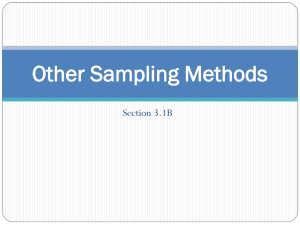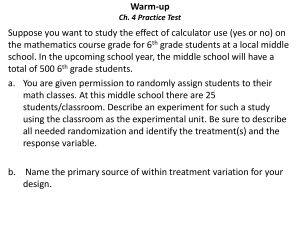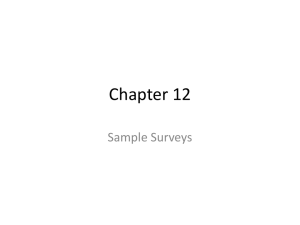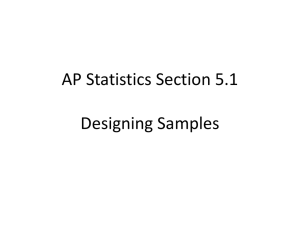Experimental Design - Count with Kellogg
advertisement
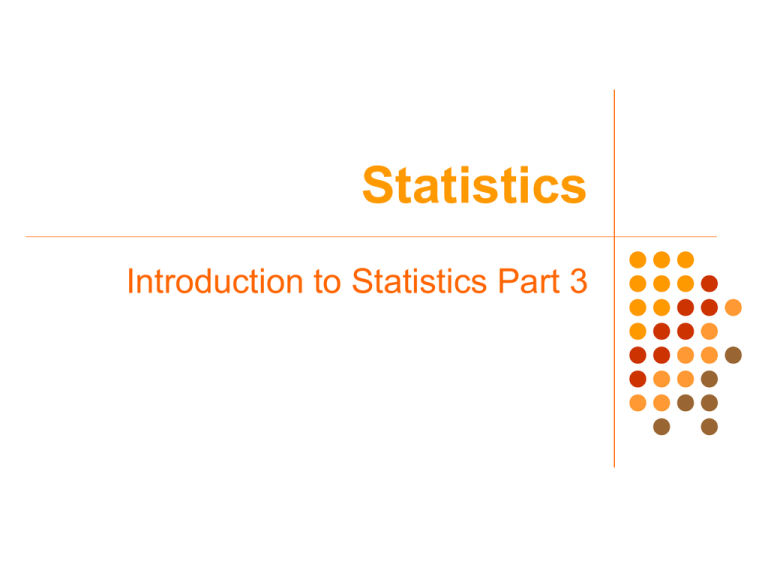
Statistics Introduction to Statistics Part 3 Warm-up Identify as qualitative or quantitative: Daily low temperature for September. Player numbers for the football team. Identify the level of measurement: The three political parties in congress: democrat, republican, and independent. The length of 10 striped bass caught off Buzzard’s Bay. Warm-up What would be the best method to collect the following data: A study of the effect of a product’s warning label on consumers willingness to buy the product. A study of MA high school students performance on the MCAS tests. A study to determine if a new Math program will increase elementary students math performance on the MCAS exam. Warm-up A study of the world’s busiest airports was conducted by Airports Council International. Describe three variables that one could use to determine which airports are the busiest. What units would you use to measure these variables? Are the discrete or continuous? What level of measurement are they? Warm-up A study of 2958 collegiate soccer players showed that 46 players suffered ACL tears. Of these 46 players, 36 were women. What percent of players who experienced tears are women? For men? Can it be concluded that women soccer players tear their ACL more often than men? How might this study’s conclusion might have been reached? Warm-up A statistics instructor wants to see if allowing students to use note cards on exams will affect their overall exam scores. Thinking that the results could be affected by the type of class: traditional, webenhanced, or online; the instructor randomly selects half his students from each class to use note cards. At the end of the class, the average exam grades are compared for those using note cards and those without note cards. What type of design is this? What is the response variable? What are the treatments? What factors were being controlled? Agenda Warm-up Homework Review Objectives Discuss how to design a statistical study Discuss data collection techniques Discuss how to design an experiment Discuss sampling techniques Summary Homework Designing a Statistical Study 1. 2. Identify and define the variable(s) of interest (the focus) and the population of the study. Develop a detailed plan for collecting data. If you use a sample, make sure the sample is representative of the population. 3. 4. 5. 6. Collect the data. Describe the data using descriptive statistics techniques. Interpret the data and make decisions about the population using inferential statistics. Identify any possible errors. Data Collection Observational study A researcher observes and measures characteristics of interest of part of a population. Example: Researchers observed and recorded the mouthing behavior on nonfood objects of children up to three years old. (Source: Pediatric Magazine) Data Collection Experiment A treatment is applied to part of a population and responses are observed. Example: An experiment was performed in which diabetics took cinnamon extract daily while a control group took none. After 40 days, the diabetics who had the cinnamon reduced their risk of heart disease while the control group experienced no change. (Source: Diabetes Care) Data Collection Simulation Uses a mathematical or physical model to reproduce the conditions of a situation or process. Often involves the use of computers. Example: Automobile manufacturers use simulations with dummies to study the effects of crashes on humans. Data Collection Survey An investigation of one or more characteristics of a population. Commonly done by interview, mail, or telephone. Example: A survey is conducted on a sample of female physicians to determine whether the primary reason for their career choice is financial stability. Example: Methods of Data Collection Consider the following statistical studies. Which method of data collection would you use to collect data for each study? 1. A study of the effect of changing flight patterns on the number of airplane accidents. Solution: Simulation (It is impractical to create this situation) Example: Methods of Data Collection 2. A study of the effect of eating oatmeal on lowering blood pressure. Solution: Experiment (Measure the effect of a treatment – eating oatmeal) Example: Methods of Data Collection 3. A study of how fourth grade students solve a puzzle. Solution: Observational study (observe and measure certain characteristics of part of a population) Example: Methods of Data Collection 4. A study of U.S. residents’ approval rating of the U.S. president. Solution: Survey (Ask “Do you approve of the way the president is handling his job?”) Key Elements of Experimental Design Control Randomization Replication Key Elements of Experimental Design: Control Control for effects other than the one being measured. Confounding variables (Extraneous or lurking) Occurs when an experimenter cannot tell the difference between the effects of different factors on a variable. Example : A coffee shop owner remodels her shop at the same time a nearby mall has its grand opening. If business at the coffee shop increases, it cannot be determined whether it is because of the remodeling or the new mall. Key Elements of Experimental Design: Control Placebo effect A subject reacts favorably to a placebo when in fact he or she has been given no (medical) treatment at all. Blinding is a technique where the subject does not know whether he or she is receiving a treatment or a placebo. Double-blind experiment neither the subject nor the experimenter knows if the subject is receiving a treatment or a placebo. Other Effects found in Research Hawthorne effect The Hawthorne effect occurs when research study participants know they are being studied and alter their performance because of the attention they receive from the experimenters. Experimenter effect An experimenter effect occurs when the experimenters subtly communicate their expectations to the participants, who alter their behavior to conform to these expectations. Other Effects found in Research Rosenthal or Pygmalion effect The Pygmalion effect occurs when students alter their behavior to meet teacher expectations. John Henry effect The John Henry effect occurs when the participants in the control group alter their behavior out of awareness that they are in the control group. Key Elements of Experimental Design: Randomization Randomization is a process of randomly selecting subjects for a study and/or assigning subjects to different treatment groups. Completely randomized design Subjects are randomly selected for the study, then assigned to different treatment/control groups through random selection. Randomized block design Divide randomly selected subjects with similar characteristics into blocks, and then within each block, randomly assign subjects to treatment groups. Key Elements of Experimental Design: Randomization Randomized block design An experimenter testing the effects of a new weight loss drink may first divide the subjects into age categories. Then within each age group, randomly assign subjects to either the treatment group or control group. Key Elements of Experimental Design: Randomization Matched Pairs Design Subjects are paired up according to a similarity. One subject in the pair is randomly selected to receive one treatment while the other subject receives a different treatment. Key Elements of Experimental Design: Replication Replication is the repetition of an experiment using a large group of subjects. Example: To test a vaccine against a strain of influenza, 10,000 people are given the vaccine and another 10,000 people are given a placebo. Because of the sample size, the effectiveness of the vaccine would most likely be observed. Example: Experimental Design A company wants to test the effectiveness of a new gum developed to help people quit smoking. Identify a potential problem with the given experimental design and suggest a way to improve it. The company identifies one thousand adults who are heavy smokers. The subjects are divided into blocks according to gender. After two months, the female group has a significant number of subjects who have quit smoking. Solution: Experimental Design Problem: The groups are not similar. The new gum may have a greater effect on women than men, or vice versa. Correction: The subjects can be divided into blocks according to gender, but then within each block, they must be randomly assigned to be in the treatment group or the control group. Sampling Techniques Simple Random Sample Every possible sample of the same size has the same chance of being selected. x x x xxxxx x xx x x x xx x xx x x x xx x xx xx x x x x x x x x xx x x x x xx x x x x xx x x x x x x x x x x x xx x xx x x xxxx x x x x x xx x x xx x x x x x x x x x xx xx xx x x x xx x Simple Random Sample • Random numbers can be generated by a random number table, a software program or a calculator. • Assign a number to each member of the population. • Members of the population that correspond to these numbers become members of the sample. Example: Simple Random Sample There are 731 students currently enrolled in statistics at a local college. You wish to form a sample of eight students to answer some survey questions. Select the students who will belong to the simple random sample. • Assign numbers 1 to 731 to each student taking statistics. • On the table of random numbers, choose a starting place at random (suppose you start in the third row, second column.) Solution: Simple Random Sample • Read the digits in groups of three • Ignore numbers greater than 731 The students assigned numbers 719, 662, 650, 4, 53, 589, 403, and 129 would make up the sample. Other Sampling Techniques Stratified Sample Divide a population into groups (strata) and select a random sample from each group. • To collect a stratified sample of the number of people who live in Norfolk County households, you could divide the households into socioeconomic levels and then randomly select households from each level. Other Sampling Techniques Cluster Sample Divide the population into groups (clusters) and select all of the members in one or more, but not all, randomly selected clusters. • In West Ridge County you could divide the households into clusters according to zip codes, then select all the households in one or more, but not all, zip codes. Other Sampling Techniques Multistage Sampling Similar to cluster sampling Divide the population into groups (clusters) and randomly select certain clusters, then randomly select a certain number of the members from each of the selected clusters. Example: Neilson selects families by randomly selecting neighborhoods, then randomly selecting a family or families from those selected heighborhoods. Other Sampling Techniques Systematic Sample Choose a starting value at random. Then choose every kth member of the population. • In the Norfolk County example you could assign a different number to each household, randomly choose a starting number, then select every 100th household. Other Sampling Techniques Convenience Samples A sample that is literally convenient to the researcher. Concern- They are inherently biased as they do not typically represent the population. Example – A researcher wants to study the attitudes of high school students taking statistics. The researcher Surveys his class. Other Sampling Techniques Volunteer Samples Subjects seek out the researcher to participate in the study Inherent bias – Subjects are motivated to participate and may not represent the population. Example – A television news program as people to respond to a poll question. Other Sampling Techniques Purposive Samples Subjects are chosen because they have certain characteristics. Example A medical research wants to study the effects of a new medication for relief of migraine. She advertises on television for participants. Then the researcher screens those candidates to find ones that have the appropriate medical condition. Other Sampling Techniques Issues for other sampling techniques– Most are inherently biased. Caution- results cannot be applied to the larger population. They can provide very useful information. They can be the subject of meta analysis. Example: Identifying Sampling Techniques You are doing a study to determine the opinion of students at your school regarding stem cell research. Identify the sampling technique used. 1. You divide the student population with respect to majors and randomly select and question some students in each major. Solution: Stratified sampling (the students are divided into strata (majors) and a sample is selected from each major) Example: Identifying Sampling Techniques 2. You assign each student a number and generate random numbers. You then question each student whose number is randomly selected. Solution: Simple random sample (each sample of the same size has an equal chance of being selected and each student has an equal chance of being selected.) Summary Discussed how to design a statistical study Discussed data collection techniques Discussed how to design an experiment Discussed sampling techniques Homework Pg 21-22; # 1-21 odd

